
Tags
Share
Artificial Intelligence (AI) has swiftly transitioned from being a futuristic concept to a pivotal element in the business world. It’s no longer just a buzzword—it's a game-changer.
Companies of all sizes are tapping into AI to streamline operations, enhance customer experience, and unlock unprecedented efficiency. As we examine the diverse impacts of AI, it becomes clear that this technology is not merely a tool for efficiency but a catalyst for redefining the very nature of AI in the workplace.
In this post, we will explore the transformative role of AI in the workplace. By automating routine tasks, personalizing customer engagement, and enhancing omnichannel communication, AI is not only boosting workplace productivity but also fostering innovative approaches.
Defining AI in the workplace
The applications of AI in the workplace are vast and varied, showcasing its adaptability and extensive potential. From enhancing communication through natural language processing and speech recognition to bolstering security via fraud detection, AI's capabilities extend into virtually every aspect of professional environments.
As individuals and organizations grow more familiar with AI technologies, their trust in these systems naturally increases. In fact, 49% of executives feel they can somewhat trust AI. This growing familiarity allows users to better understand how AI functions, what it can do, and its limitations, dispelling fears and misconceptions.
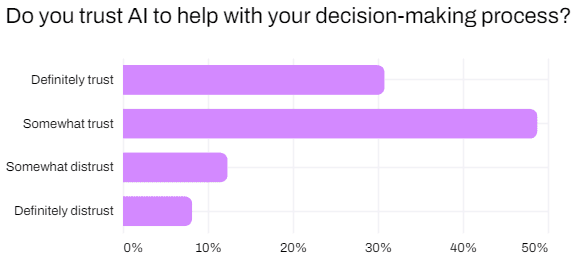
Moreover, its use in fields like medical diagnostics underscores its critical role in not only improving business processes but also in contributing to societal advancements. This broad spectrum of functionalities illustrates why AI is becoming an integral part of modern workplaces.
The power of AI and automation
Automated customer service
Imagine a world where your customers receive instant, accurate responses 24/7. AI customer service makes this a reality which drastically reduces wait times and improves customer engagement. AI-powered chatbots can handle and resolve common customer inquiries, freeing up employees to focus on more complex tasks. This not only saves time but also reduces the risk of unnecessary error.
Streamlining Operations
AI has the potential to make mundane tasks a thing of the past. Through automation, businesses can save countless hours spent on repetitive processes like data entry or scheduling even as far as creating websites, with the help of AI website builders, you can bridge the gaps between time consumed and quality of the outcome.
With the help of AI, these tasks can be completed faster and more accurately, enabling employees to focus on higher-level responsibilities that require human creativity and problem-solving skills. This not only improves productivity but also drives innovation within the company.
Data analysis and insights
Data is the currency of the digital age, and AI has the ability to unlock its full potential. Through advanced data analysis, companies can gain valuable insights into customer behavior, market trends, and business operations. This information can be used to make informed decisions, predict future trends, and identify areas for improvement.
AI and strategic insights
One of the most significant benefits of AI in the workplace is its ability to analyze vast amounts of data and provide actionable insights. This goes beyond just basic data analysis—AI can process and interpret complex patterns and trends that would be difficult for humans to identify on their own.
Sales AI
Sales teams are now equipped with AI tools that allow them to forecast customer needs, tailor their pitches, and expedite deal closures by analyzing data patterns and producing actionable insights.
These tools powered by sales AI provide predictive insights that inform sales teams about the optimal times to reach out to potential customers, the most effective communication channels, and the kinds of messages or offers that are likely to appeal to each unique prospect.
With sales AI, every sales call planning becomes a strategic process, significantly boosting the chances of a successful outcome.
Leveling up the sales playbook
The traditional sales playbook is getting a major upgrade with the adoption of AI. Instead of relying on static strategies and generalized approaches, sales teams are now using AI to dynamically adjust their sales playbooks.
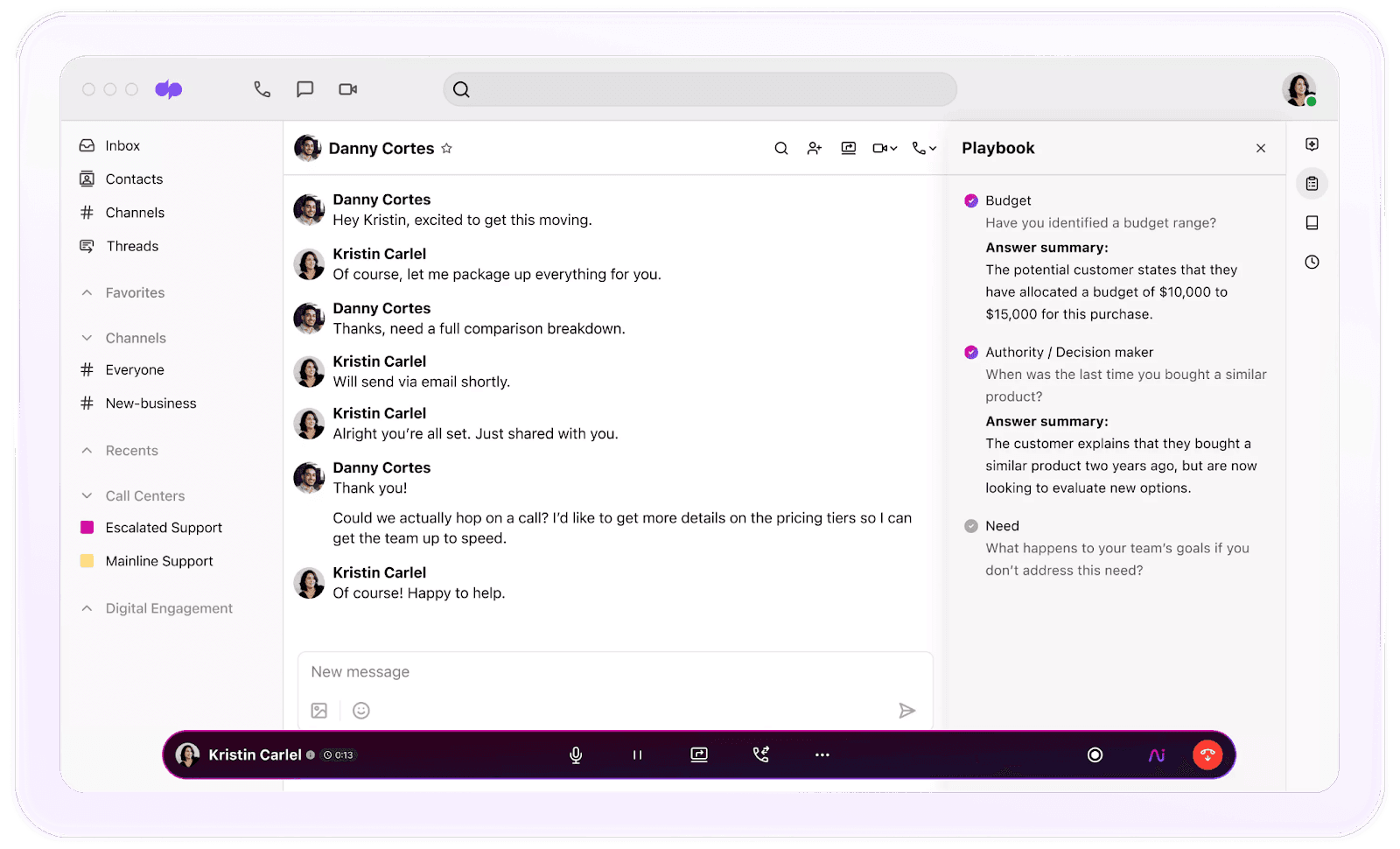
By analyzing ongoing sales data and market trends in real time, AI can suggest adjustments to sales coaching and sales call planning, helping teams to stay ahead of the curve and adapt to changing customer behaviors and expectations swiftly.
Closing deals with precision and efficiency
The ultimate goal of integrating AI into sales operations is to close deals more efficiently. By having access to detailed customer insights and predictive analytics, sales teams can approach each negotiation with a personalized strategy, increasing the likelihood of a favorable outcome.
An AI at work report found that efficiency is considered one of the top benefits users expect when using AI. It is essential for businesses aiming to enhance their operations and simplify procedures. The efficiency of AI-enabled tools allows sales teams to prioritize their efforts on leads that show the highest potential for conversion, optimize their sales funnel, and ultimately, close deals at a faster rate.
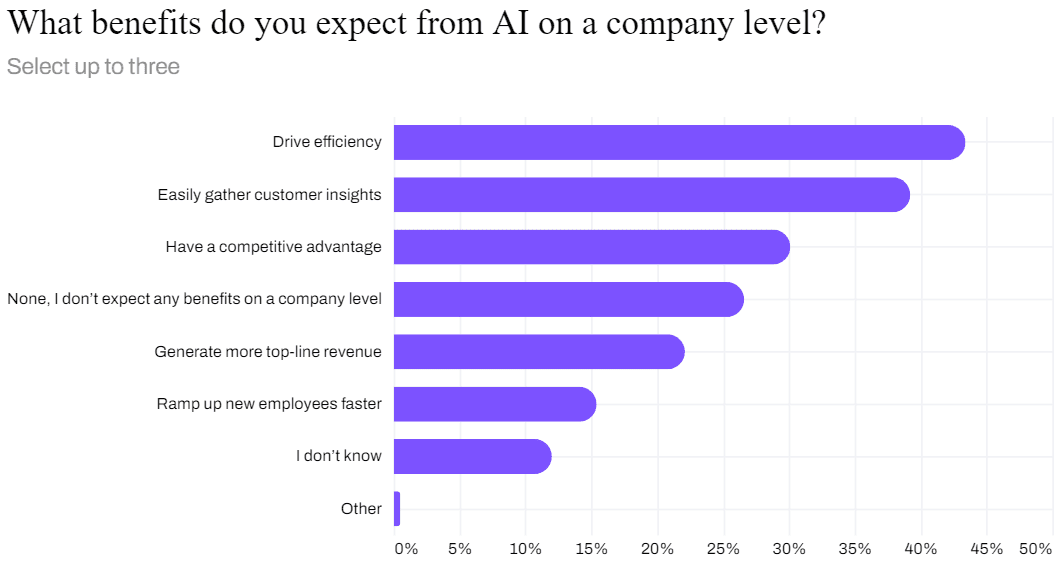
By harnessing AI in sales call planning, sales playbook adaptation, and strategic deal closure, sales teams are not just working harder—they're working smarter. This approach not only elevates the effectiveness of sales activities but also contributes to a more personalized and satisfying customer experience, creating a competitive edge in today’s dynamic market.
Workplace efficiency and productivity
AI can streamline processes such as scheduling, customer service, and inventory management, allowing employees to focus on more complex and creative tasks. This shift not only speeds up operations but also improves job satisfaction by reducing mundane activities. An AI in customer service report found that almost 60% of customer service professionals responded that using AI has saved them time, while nearly half also stated that AI simplifies their work.
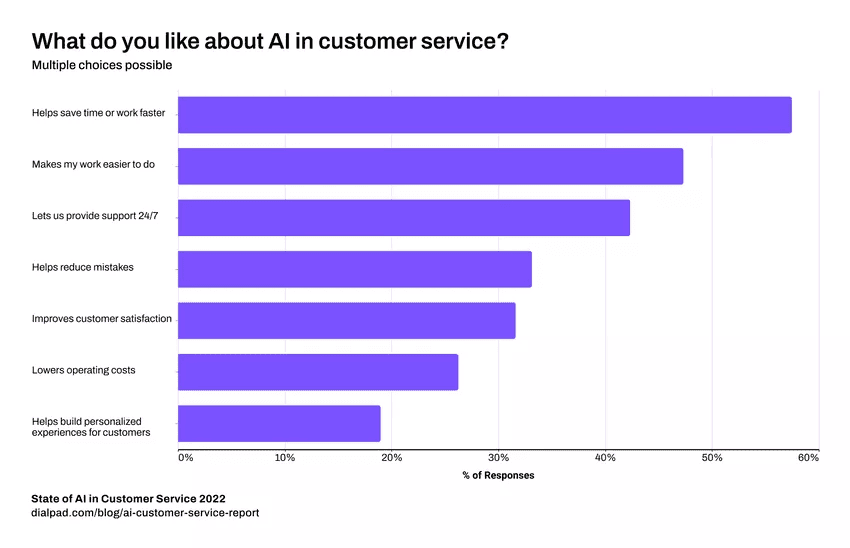
By automating mundane tasks, employees can focus on high-value activities. Unified communication platforms like Dialpad transform how teams communicate and collaborate, ensuring smooth operation and productivity.
Assaf Parag, founder and CEO at Opinion Stage, mentioned that AI is really revolutionizing the workplace by enhancing efficiency and productivity. From automating routine tasks to providing advanced data analytics, AI enables employees to focus on more strategic and creative aspects of their roles.
The integration of AI tools is not just about replacing manual processes; it's about augmenting human capabilities and fostering innovation in ways previously unimaginable.
Gaetano DiNardi, a growth advisor to top B2B SaaS companies, says that scaling content with generative AI may also pose significant risks if not done carefully. For example, ZoomInfo has experienced tremendous traffic losses with its programmatic SEO pages following the latest round of Google algorithm updates in recent years.
With creating content using AI becoming a norm, brands who master this responsibly will truly stand out with users as well as search engines.
Leveraging AI and data
Real-time insights and decision making
Real-time insights allow employees to make informed decisions quickly, reducing the time spent on analysis and increasing the accuracy of their actions. By having access to up-to-the-minute data, employees can identify and address issues immediately, enhancing their ability to respond to dynamic market conditions effectively.
For example, AI-driven real-time customer insights are crucial for understanding customer behaviors and preferences. This knowledge enables employees, particularly those in customer service and sales roles, to personalize interactions and improve customer experiences. Tailoring approaches based on these insights can lead to higher customer satisfaction and loyalty, directly impacting business success.
Predictive analytics
Predictive analytics not only forecast trends and demands but also anticipate customer needs. This capability helps employees stay proactive rather than reactive. By understanding what the future may hold, teams can prepare better, align their resources more efficiently, and optimize their strategies to meet anticipated conditions, thus enhancing overall performance.
Improving strategic planning
With AI-generated insights, strategic planning becomes more informed and agile. Employees can develop and execute strategies that are precisely aligned with current and future market trends. This helps companies remain competitive and responsive, empowering employees to adapt strategies as the market evolves, ensuring continuous improvement and innovation in their roles.
Enhancing communication and engagement
Conversational AI
From chatbots to virtual assistants, conversational AI is transforming the way businesses interact with customers, making communications more seamless, tailored, and engaging. It adapts to user preferences and learning from interactions to improve its responses over time, significantly enhancing customer satisfaction and loyalty.
Conversational AI is great at understanding complex needs and different ways of talking, thanks to natural language processing (NLP) and deep learning. It keeps getting smarter as it learns from common questions and patterns in customer conversations. This technology also aids agents in meeting customer needs, leading to increased work efficiency and improved performance.
Improved employee-customer interaction
AI tools like Dialpad Ai also facilitate better communication within teams and between employees and customers, enhancing overall engagement and satisfaction.
For example, AI-powered systems can provide real-time assistance to agents by suggesting responses based on customer sentiment analysis and past interaction history. This not only speeds up resolution times but also ensures that customer queries are handled more efficiently and accurately.
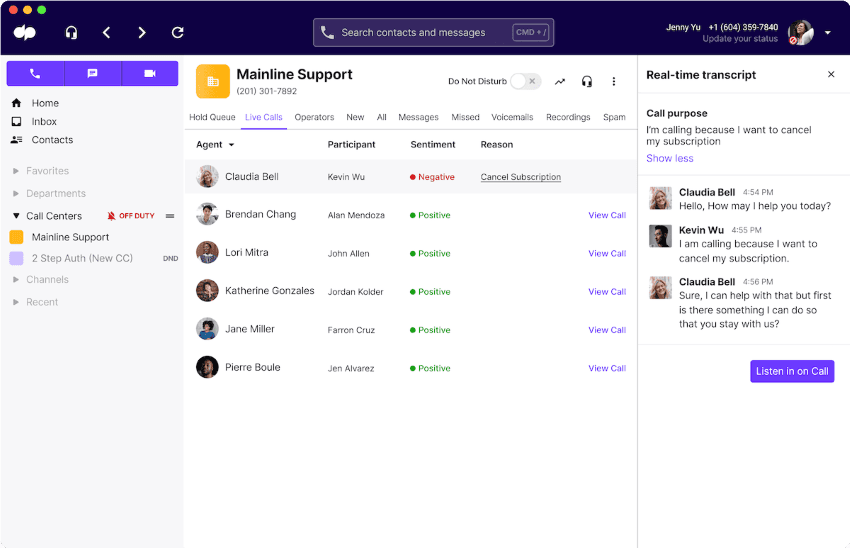
In contact centers, AI also helps monitor call quality and agent performance, offering continuous feedback and training opportunities to improve service levels. With contact center AI, teams can significantly enhance their operational efficiency and customer satisfaction, leading to improved business outcomes.
Creating a seamless experience
AI-driven tools can automate data entry, scheduling, and email management, freeing up employees to focus on more strategic and creative tasks.
Additionally, AI can help streamline decision-making processes by providing analytics and insights that would otherwise take days to compile manually. This integration of AI in the workplace not only boosts productivity but also enhances job satisfaction by reducing the workload and stress associated with repetitive tasks.
Moreover, AI-powered systems can customize learning and development programs for employees, ensuring they receive training that is tailored to their specific needs and career goals.
Streamlining customer support with AI
To truly harness the power of AI in improving customer experiences, businesses are implementing intelligent virtual assistants that go beyond basic FAQ interactions. For instance, a retail company might use an AI-powered system like Zendesk or Intercom to provide personalized shopping advice or manage returns and exchanges directly through chat.
These systems can analyze customer purchase history, browsing behavior, and even sentiment, to deliver tailored support without human intervention. This not only boosts efficiency but significantly enhances the customer's shopping experience, making it more satisfactory and seamless.
Omnichannel communication
Omnichannel communication is increasingly important in the workplace because it ensures a consistent and seamless interaction across multiple communication channels. The goal? To make interactions effortless, consistent, and efficient, no matter the channel.
This approach integrates various forms of communication such as email, chat, social media, voice calls, and video conferencing into a single, unified interface. By doing so, it allows employees to interact with colleagues and customers more effectively, regardless of the platform being used.
The importance of omnichannel communication lies in its ability to enhance collaboration among team members who may be working from different locations or using different devices.
With tools like Dialpad Ai, teams can easily integrate AI-driven insights and automation across all communication channels, streamlining workflows and enhancing the overall workplace experience. Remember, in the digital age, a smooth and unified communication strategy isn’t just nice to have—it’s essential.
The role of generative AI
Content creation
Generative AI tools are adept at automating various aspects of content creation, such as drafting marketing copy and generating reports. This automation not only saves valuable time but also reduces the repetitive, manual tasks that can often be time-consuming for your team.
With generative AI handling the more routine content creation tasks, employees are liberated to explore new ideas, strategies, and innovative concepts. The freedom from mundane tasks allows them to channel their inner creativity, experiment with novel approaches, and push the boundaries of traditional marketing practices. These generative AI use cases lead to more innovative campaigns and content that resonate with audiences in unique ways.
However, according to Nishadha Silva, a growth marketer at Creately, to create exceptional content using generative AI you need to take the time to train your model. If you’re using a tool then you need to look at if they have features to train their model using a set of brand assets you provide. If not you can get outside help to create your own model that can generate the content as exactly as you want.
With creating content using AI becoming a norm, brands who master this will truly stand out with users as well as search engines.
Data-driven insights
Generative AI can analyze data trends and performance metrics to generate insights that inform team strategies. By using this technology, teams can make smart decisions with real-time data, tweaking campaigns to get better engagement, more conversions, and just overall better results.
This data-driven method boosts the return on investment (ROI) of marketing campaigns and makes sure that it really clicks with the target audience.
Teams can leverage real-time data to fine-tune their marketing campaigns, ensuring that each piece is optimized for maximum engagement and conversion. This iterative, data-driven method allows for continuous refinement of campaign strategies, ensuring they are aligned with the evolving preferences of the target audience.
Evolving workplace creativity
By handling the heavy lifting, generative AI tools allow teams to push the boundaries of creativity, exploring new ideas and concepts with ease. By taking over the time-consuming aspects of content generation, data analysis, and other repetitive activities, generative AI tools enable individuals to dedicate more time to brainstorming, experimenting with new ideas, and pushing the boundaries of conventional thinking.
This shift not only enhances productivity but also fosters an environment ripe for innovation, where team members can explore diverse concepts and engage in dynamic collaboration without the constraints of mundane responsibilities.
Furthermore, generative AI accelerates the experimentation and development phase of creative projects, allowing for rapid prototyping and agile decision-making. Teams can leverage AI-generated insights and suggestions to fuel their creative exploration, challenging established norms and exploring novel solutions.
The adoption of generative AI in creative workflows empowers leaders to inspire their teams towards bold initiatives and cultivate a culture of continuous learning and improvement. In doing so, organizations can stay ahead of market trends, adapt to the changing landscape, and sustain a competitive edge through enhanced creativity and innovation.
Scalability and consistency
Generative AI's scalability and consistency play pivotal roles in transforming workplace efficiency and productivity. With scalability, businesses can leverage AI to handle tasks ranging from simple to complex, across various volumes, without the need for additional resources. This adaptability means that as a company grows or its needs change, generative AI systems can adjust accordingly, ensuring that operations remain smooth and uninterrupted.
Consistency is another critical benefit. Generative AI can perform tasks, analyze data, and provide insights with a level of uniformity that is hard to achieve through human efforts alone. This consistency in performance and output quality reduces errors and improves reliability in processes, decision-making, and customer interactions.
Together, scalability and consistency in generative AI technologies enable businesses to optimize their operations, foster innovation, and maintain a competitive edge in their industry.
Implementing AI: Concrete Examples from the field
Communication
Take the case of Dialpad Ai, which exemplifies the transformation in workplace communication. This goes beyond automating call transcriptions; it's about analyzing voice interactions in real time to provide customer sentiment analysis, suggest actionable insights during a call, and even recommend responses to sales reps or support agents. This kind of AI application isn't just about efficiency—it's about enhancing the quality of every customer interaction.
Retail
Or consider a retail giant like Amazon, which uses predictive analytics to not just recommend products to consumers based on previous purchases but also to optimize its inventory management. By forecasting upcoming buying trends, Amazon preemptively stocks items poised for high demand, guaranteeing customers access to what they need precisely when they need it. This strategy reinforces Amazon's leadership in market responsiveness.
Content
In the realm of content creation, AI tools like OpenAI's GPT-4 are revolutionizing how content is generated. From drafting email responses to creating marketing copy or even generating code, GPT-4 has shown the potential to save hours of human effort while maintaining a high level of creativity and customization.
That said, AI content writers are far from perfect at the moment.
According to Adam Connell of Blogging Wizard: “While you can use AI to write entire articles and publish them blindly, that's not the approach I recommend. If you care about your readers, AI should be an aid and not a crutch. I've found AI quite useful for breaking through writer's block, uncovering topic ideas that I wouldn't have thought of myself, and improving existing content. It gives you the ability to speed up most parts of the content creation process. And this is just scratching the surface.”
Looking ahead: The future of AI in the workplace
Emerging trends and technologies promise even greater efficiencies, smarter solutions, and more personalized customer experiences. The challenges are there—data privacy, ethical considerations, and the need for ongoing learning—but so are the opportunities for those ready to adapt and innovate.
AI is undeniably strengthening the workplace, offering tools and technologies to streamline operations, enhance decision-making, and foster a more creative, engaged workforce. For businesses willing to adapt, the possibilities are endless. With examples like Dialpad Ai leading the way in business communications, the path forward is clear: integrating AI into daily operations is essential for staying competitive inside the arena of innovation.
Improve your workplace communications with Dialpad Ai
Looking for a platform that can handle different communication channels for your team? Sign up for a 14-day trial of Dialpad's truly unified communications platform to try it for free—it takes just a few minutes. Or, take a self-guided tour and play around with Dialpad first!








